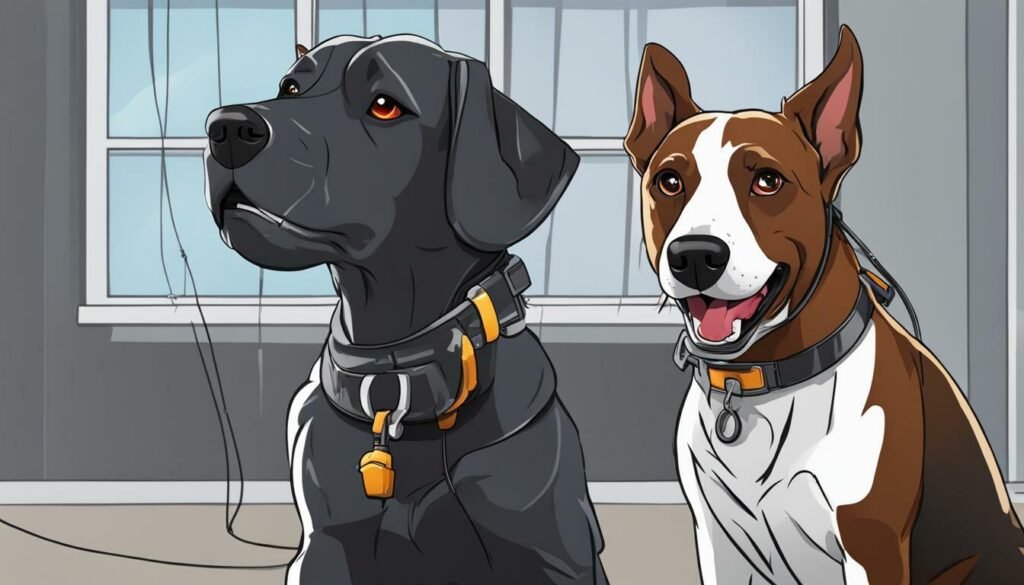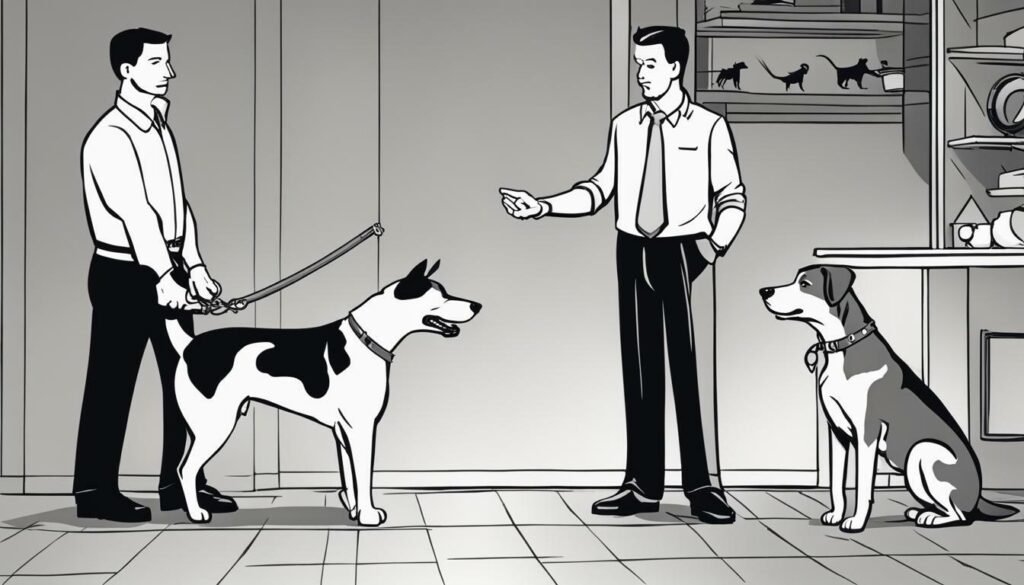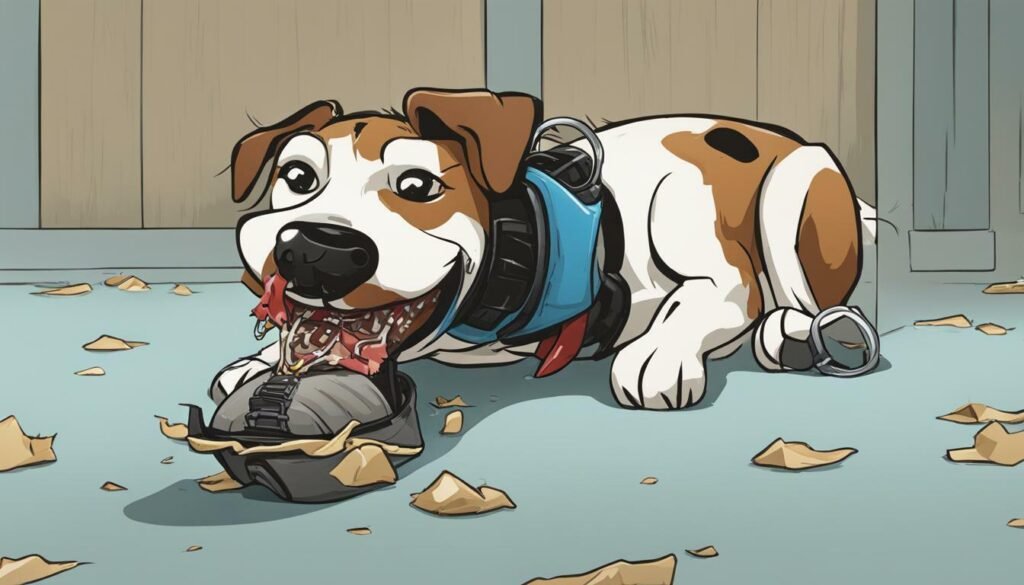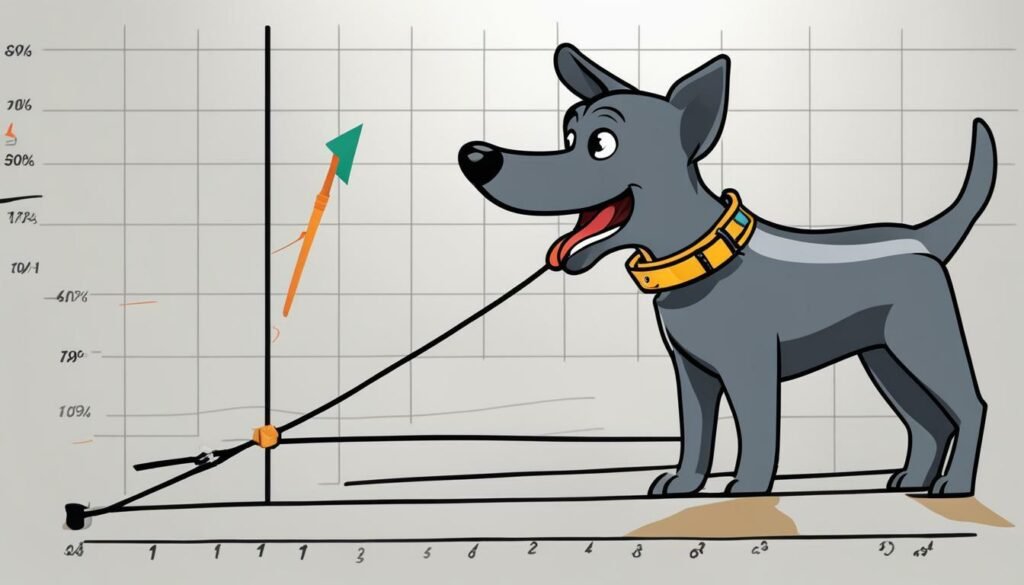Are you struggling with your dog’s bad behavior and looking for a solution? A shock collar may be a helpful training tool, but it’s important to use it properly to avoid causing harm to your furry friend. In this section, we will provide you with an effective guide on how to use a shock collar to address your dog’s bad behavior.

Key Takeaways
- Shock collars can be an effective training tool for addressing bad behavior in dogs.
- It’s essential to choose the right shock collar for your dog’s size, temperament, and specific behavior issues.
- Introducing your dog to the shock collar in a positive and gentle manner is crucial.
- Learning the proper technique for administering shocks is important to ensure effective training without causing harm to your dog.
- Reinforcing positive behavior in conjunction with the shock collar can promote long-term behavior change.
Understanding Shock Collars and Their Purpose
If you’re considering using a dog shock or electronic collar to address your dog’s bad behavior, it’s important to understand what these collars are and how they work.
Shock collars are training devices that deliver an electric shock to your dog’s neck when activated. The purpose of these collars is to stop unwanted behaviors and encourage better obedience.
While shock collars can be effective tools when used correctly, it’s important to remember that they are not a substitute for proper dog training and positive reinforcement. Shock collars should only be used as a last resort when other dog training methods have failed.
There are different types of shock training collars available for dogs training, each with its own features and settings. Some collars have a range of intensity levels, while others come with remote controls that allow you to adjust the shock level from a distance. It’s essential to choose a collar that’s appropriate for your dog’s size and temperament and one that addresses the specific undesirable behavior issues you’re experiencing.

When used responsibly and ethically, shock collars can be an effective tool that is used to train your dog to stop bad behavior. However, it’s important to remember that shock collars should never be used to punish or harm your dog. Instead, they should be used to provide your dog with clear boundaries and expectations, helping them to become a happier and healthier companion.
Choosing the Right Shock Collar for Your Dog
When selecting a shock collar for your furry friend, several factors should influence your decision. The right collar will depend on your dog’s size, breed, and temperament, as well as the behavior you’re trying to correct.
Consider the size of your dog when choosing a collar. A small dog may require a different type of collar compared to a larger dog. Also, consider the temperament of your dog when selecting a collar. If your dog is easily agitated or anxious, you may want to choose a collar with adjustable intensity settings that allow you to start with a low setting and gradually increase as needed.
Be sure to do your research and choose a collar that is appropriate for the behavior you’re trying to correct. For example, if your dog is jumping on furniture, a collar with a remote control and vibration setting may be more effective than a basic model.
| Factors to Consider | Tips |
|---|---|
| Size of Dog | Choose a collar appropriate for your dog’s size |
| Dog’s Temperament | Select a collar with adjustable intensity settings for easily agitated dogs |
| Behavior You’re Targeting | Research different collars and select one appropriate for the specific behavior you’re addressing |
Remember that proper use of the shock collar is crucial to ensure your dog’s safety and comfort. Always read and follow the manufacturer’s instructions for the collar you choose, and never leave the collar on your dog for extended periods of time.
Choosing the right shock collar for your dog can mean the difference between effective training and unnecessary discomfort. Take the time to research and select a collar that’s appropriate for your furry friend.

How to Introduce Your Dog to the Shock Collar
Proper introduction to the shock collar is crucial in ensuring effective dog training. This process should be done in a positive and gentle manner to create a positive association with the collar. Your dog should never be scared or stressed during this process.
Start by placing the collar on your dog’s neck without turning it on. Let your dog sniff and explore the collar while giving treats and praise. This will help your dog associate the collar with positive experiences.
Once your dog is comfortable wearing the collar, it’s time to turn it on. Begin by using the lowest possible setting and see how your dog reacts. Watch for any signs of distress, such as whimpering, yelping, or cringing.
If your dog shows any signs of distress, stop immediately and go back to positive reinforcement training. If your dog is comfortable, continue with the training by rewarding your dog with treats and praise whenever the collar is on.

It’s important to note that shock collars should never be used as a punishment or to cause harm to your dog. It is a dog training tool that, when used correctly, can help address bad behavior and promote positive reinforcement training.
Tips for Introducing Your Dog to the Shock Collar
- Always start with the lowest possible setting
- Use positive reinforcement, like treats and praise, to create a positive association
- Stop immediately if your dog shows signs of distress
How to Properly use a shock collar to Stop Bad Behavior of Your Dog- Learning the Proper Technique
Now that you’ve introduced your dog to the shock collar, it’s essential to understand the proper technique for administering shocks. Remember that the shock collar is a training tool, not a punishment device, and should be used responsibly and ethically.
First, always start with the lowest intensity setting. It’s crucial to find the correct level that is effective without causing harm to your dog. Using a higher level than necessary can lead to fear, anxiety, and physical injury.
The timing of the shock is also essential. The shock should be administered at the precise moment your dog engages in the unwanted behavior. This timing helps your dog understand that the unwanted behavior leads to the unpleasant sensation, making your dog less likely to repeat it.
Consistency is also important for successful dog training with the shock collar. The same intensity level should be used consistently for each instance of the unwanted behavior, without changing the intensity level unpredictably. Such actions can cause confusion and undermine the training.
Remember to use the shock collar alongside positive reinforcement dog training techniques. This approach will help your dog learn the desired behavior while still feeling loved and rewarded.

It’s essential to be patient and consistent to achieve the desired behavior in your dog. With proper technique and positive reinforcement, you can train your dog to stop unwanted behavior successfully.
How You can use a Shock Collar to Address Specific Bad Behavior in Your Dog
Using a shock collar to correct specific bad behaviors in your dog, it’s important to first identify the issue you wish to address. Some common behaviors that may be effectively addressed using a shock collar include:
- Barking excessively
- Jumping on people
- Chewing or destructive behavior
- Aggression towards other dogs or people
- Aggressive Behavior
Once you have identified the behavior you wish to correct, it’s important to follow the proper technique for administering shocks, as discussed in section 5. For example, if your dog barks excessively, you should use a verbal command or trigger to prompt the bark, then administer the shock immediately to interrupt the behavior. This will help your dog associate the shock with the unwanted behavior, and eventually reduce or eliminate the behavior altogether.
It’s important to note that while shock collars can be effective in addressing bad behavior, they should never be used as a punishment or form of aggression towards your dog. Always use the collar responsibly and humanely, and be sure to reinforce positive behavior in conjunction with its use, as discussed in section 7.

Remember that using a shock collar is not a substitute for proper training and socialization. If your dog displays aggressive or dangerous behavior, consult with a professional trainer or behaviorist for guidance and support.
Positive Reinforcement is the Best way to stop unwanted behavior of Your Dog using Shock Collar
In addition to using the shock collar to address your dog’s bad behavior, it’s important to reinforce positive behavior as well. Positive reinforcement is a powerful training technique that uses rewards to encourage good behavior, making your dog more likely to repeat that behavior in the future.
Use verbal praise, treats, and toys to reward your dog when they exhibit good behavior. This reinforces the positive behavior and encourages them to continue it. Remember, positive reinforcement should always be used with the shock collar, not as a replacement.
When reinforcing positive behavior, it’s important to be consistent. Reward your dog every time they exhibit the desired behavior, and be sure to use the same reward each time. This reinforces the connection between the behavior and the reward, making it more likely that your dog will repeat the behavior.
As you continue to use the shock collar and reinforce positive behavior, you may find that your dog’s behavior improves more quickly and effectively. Rewarding positive behavior is an important component of using the shock collar responsibly and effectively.

Remember, the shock collar is a tool to be used with other dog training techniques. Positive reinforcement can help create lasting behavior change and a stronger bond between you and your dog.
Why is my dog not responding to the shock collar?
Monitoring your dog’s progress throughout the shock collar training process is crucial for ensuring the effectiveness of the training. As you use the collar, it’s essential to document your dog’s behavior changes and adjust your training methods accordingly.
One effective way to monitor progress is by keeping a record of behavioral changes before and after the use of the collar. For example, if your dog is barking excessively, record how often they bark before starting collar training. Then, track their progress by recording how often they bark after each training session.
Evaluating progress also involves paying close attention to how your dog responds to the collar. If your dog’s behavior improves after using the collar, you can gradually reduce the frequency and intensity of the shocks. However, if there is no improvement, it may be time to re-evaluate your training methods or consult a professional dog trainer.
Are shock collars painful?
It’s important to remember that shock collar training should always prioritize your dog’s safety and well-being. If you notice any negative reactions or side effects from your dog, such as fear, anxiety, or physical discomfort, stop using the collar immediately and seek professional guidance.

“Remember, every dog is unique, and progress may take time. Consistency and dedication to the training process are key to seeing positive results in your dog’s behavior.”
Gradual Phasing Out of the Shock Collar
As your dog’s behavior improves, it’s important to start phasing out the use of the shock collar. This process should be gradual and done over a period of time. Suddenly stopping the use of the collar may cause your dog to revert to old behavior patterns.
Start by reducing the frequency of collar use. If you were using it every day, try using it every other day. After a few weeks, reduce it to twice a week. Eventually, you can stop using the shock collar altogether.
It’s crucial to continue reinforcing positive behavior during this time, even without the collar. Reward your dog for good behavior with treats or praise. This will help your dog maintain the desired behavior.
If you notice your dog’s behavior starting to slip, don’t hesitate to reintroduce the collar. Gradually phase it out again once the behavior has improved.
Remember, the goal is to have a well-behaved dog without the need for a shock collar. With patience, consistency, and positive reinforcement, your dog can learn to behave without the use of aversive techniques.

Final Thought
Using a shock collar to address your dog’s bad behavior can be an effective training tool, but it must be used responsibly and ethically. Remember to always reinforce positive behavior alongside the collar’s use and gradually phase it out once your dog’s behavior improves.
Monitoring and evaluating your dog’s progress is crucial, as each dog is unique and may respond differently to the collar. It’s important to choose the right shock collar for your dog based on their size, temperament, and specific behavior issues.
Properly introducing your dog to the shock collar in a positive and gentle manner is crucial. Be sure to learn the correct technique for administering shocks, including timing, intensity, and consistency, to ensure effective training without causing harm.
Addressing specific bad behaviors with the shock collar requires careful attention and guidance. Always seek the advice of a professional if you’re unsure about how to handle a specific behavior.
Remember, the key to successful training is to remain consistent, patient, and positive throughout the process. With dedication and focus, you can effectively use a shock collar to stop your dog’s bad behavior while promoting long-term behavior change.
FAQ
How do I choose the right shock collar for my dog?
When selecting a shock collar for your dog, consider factors such as size, temperament, and specific behavior issues. It’s important to choose a collar that is appropriate for your dog’s needs and comfort.
How do I introduce my dog to the shock collar?
Introducing your dog to the shock collar should be done gradually and positively. Start by associating the collar with positive experiences, such as treats or playtime. Slowly introduce the collar and allow your dog to get used to wearing it before utilizing the shocks.
What is the proper technique for administering shocks with the collar?
The proper technique for administering shocks with the collar involves timing, intensity, and consistency. It’s important to use the collar as a corrective tool rather than a punishment. Administer shocks when necessary and reinforce positive behavior alongside the collar’s use.
Can the shock collar be used to address specific bad behaviors?
Yes, the shock collar can be used to address specific bad behaviors such as excessive barking, jumping, or aggression. However, it’s important to follow proper training techniques and seek professional guidance if needed to ensure effectiveness and safety.
How can I reinforce positive behavior while using the shock collar?
Reinforcing positive behavior alongside the use of the shock collar is crucial for long-term behavior change. Use reward-based training techniques, such as treats or praise, to complement the collar’s use and encourage positive habits.
How do I monitor and evaluate my dog’s progress with the shock collar?
Monitoring and evaluating your dog’s progress is essential. Keep track of behavior changes and make adjustments to your training approach as needed. Regularly assess your dog’s response to the collar and seek professional guidance if necessary.
When should I phase out the use of the shock collar?
As your dog’s behavior improves, it’s crucial to gradually phase out the use of the shock collar. Transition to other training methods while maintaining the desired behavior. It’s important to continue reinforcing positive behavior even without the collar.
